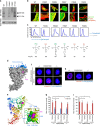A point mutation in Semaphorin 4A associates with defective endosomal sorting and causes retinal degeneration
- PMID: 23360997
- PMCID: PMC3562463
- DOI: 10.1038/ncomms2420
A point mutation in Semaphorin 4A associates with defective endosomal sorting and causes retinal degeneration
Abstract
Semaphorin 4A (Sema4A) has an essential role in photoreceptor survival. In humans, mutations in Sema4A are thought to contribute to retinal degenerative diseases. Here we generate a series of knock-in mouse lines with corresponding mutations (D345H, F350C or R713Q) in the Sema4A gene and find that Sema4A(F350C) causes retinal degeneration phenotypes. The F350C mutation results in abnormal localization of the Sema4A protein, leading to impaired endosomal sorting of molecules indispensable for photoreceptor survival. Additionally, protein structural modelling reveals that the side chain of the 350th amino acid is critical to retain the proper protein conformation. Furthermore, Sema4A gene transfer successfully prevents photoreceptor degeneration in Sema4A(F350C/F350C) and Sema4A(-/-) mice. Thus, our findings not only indicate the importance of the Sema4A protein conformation in human and mouse retina homeostasis but also identify a novel therapeutic target for retinal degenerative diseases.
Figures







Similar articles
-
Endosomal sorting by Semaphorin 4A in retinal pigment epithelium supports photoreceptor survival.Genes Dev. 2012 Apr 15;26(8):816-29. doi: 10.1101/gad.184481.111. Epub 2012 Mar 30. Genes Dev. 2012. PMID: 22465952 Free PMC article.
-
SEMA4A mutations lead to susceptibility to light irradiation, oxidative stress, and ER stress in retinal pigment epithelial cells.Invest Ophthalmol Vis Sci. 2012 Sep 28;53(10):6729-37. doi: 10.1167/iovs.11-9378. Invest Ophthalmol Vis Sci. 2012. PMID: 22956603
-
Severe retinal degeneration associated with disruption of semaphorin 4A.Invest Ophthalmol Vis Sci. 2004 Aug;45(8):2767-77. doi: 10.1167/iovs.04-0020. Invest Ophthalmol Vis Sci. 2004. PMID: 15277503
-
The role of Sema4A in angiogenesis, immune responses, carcinogenesis, and retinal systems.Cell Adh Migr. 2016 Nov;10(6):692-699. doi: 10.1080/19336918.2016.1215785. Epub 2016 Oct 13. Cell Adh Migr. 2016. PMID: 27736304 Free PMC article. Review.
-
Neuroimmune Semaphorin 4A in Cancer Angiogenesis and Inflammation: A Promoter or a Suppressor?Int J Mol Sci. 2018 Dec 30;20(1):124. doi: 10.3390/ijms20010124. Int J Mol Sci. 2018. PMID: 30598022 Free PMC article. Review.
Cited by
-
Germinal center B-cell subgroups in the tumor microenvironment cannot be overlooked: Their involvement in prognosis, immunotherapy response, and treatment resistance in head and neck squamous carcinoma.Heliyon. 2024 Sep 11;10(19):e37726. doi: 10.1016/j.heliyon.2024.e37726. eCollection 2024 Oct 15. Heliyon. 2024. PMID: 39391510 Free PMC article.
-
Immunological functions of the neuropilins and plexins as receptors for semaphorins.Nat Rev Immunol. 2013 Nov;13(11):802-14. doi: 10.1038/nri3545. Nat Rev Immunol. 2013. PMID: 24319778 Review.
-
A role of Heat Shock Protein 70 in Photoreceptor Cell Death: Potential as a Novel Therapeutic Target in Retinal Degeneration.CNS Neurosci Ther. 2016 Jan;22(1):7-14. doi: 10.1111/cns.12471. Epub 2015 Oct 28. CNS Neurosci Ther. 2016. PMID: 26507240 Free PMC article. Review.
-
RD3: a challenge and a promise.JSM Biotechnol Biomed Eng. 2013;1(3):1016. JSM Biotechnol Biomed Eng. 2013. PMID: 25679013 Free PMC article.
-
On variants and disease-causing mutations: Case studies of a SEMA4A variant identified in inherited blindness.Ophthalmic Genet. 2018 Jan-Feb;39(1):144-146. doi: 10.1080/13816810.2017.1354384. Epub 2017 Aug 14. Ophthalmic Genet. 2018. PMID: 28805479 Free PMC article.
References
-
- Pacione L. R. et al.. Progress toward understanding the genetic and biochemical mechanisms of inherited photoreceptor degenerations. Annu. Rev. Neurosci. 26, 657–700 (2003) . - PubMed
-
- Wright A. F. et al.. Photoreceptor degeneration: genetic and mechanistic dissection of a complex trait. Nat. Rev. Genet. 11, 273–284 (2010) . - PubMed
-
- Kolodkin A. L., Matthes D. J. & Goodman C. S.. The semaphorin genes encode a family of transmembrane and secreted growth cone guidance molecules. Cell 75, 1389–1399 (1993) . - PubMed
-
- Serini G. et al.. Class 3 semaphorins control vascular morphogenesis by inhibiting integrin function. Nature 424, 391–397 (2003) . - PubMed
-
- Neufeld G. & Kessler O.. The semaphorins: versatile regulators of tumour progression and tumour angiogenesis. Nat. Rev. Cancer 8, 632–645 (2008) . - PubMed
Publication types
MeSH terms
Substances
LinkOut - more resources
Full Text Sources
Other Literature Sources
Molecular Biology Databases

